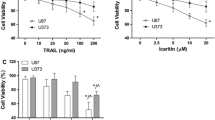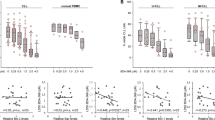Abstract
The death receptor ligand TRAIL is considered a promising candidate for cancer therapy because of its preferential toxicity to malignant cells. However its efficacy has been challenged by a number of resistance mechanisms. Therefore, agents that can overcome the resistance to enhance therapeutic efficacy of TRAIL are needed. In the current study, we found that bufalin, bufotalin and gamabufotalin, key members of bufadienolides isolated from a traditional Chinese medicine ChanSu, significantly potentiated human breast cancer cells with different status of ER-alpha to apoptosis induction of TRAIL, as evidenced by enhanced Annexin V/FITC positive cells (apoptotic cells), cytoplasmic histone-associated-DNA-fragments, membrane permeability transition (MPT), caspases activation and PARP cleavage. Further mechanistic investigation demonstrated that bufalin was able to significantly decrease Mcl-1 expression and modestly decrease Bcl-XL expression level. Down-regulations of these anti-apoptotic proteins were well correlated with inhibition of transcription factor STAT3 activation. The important consequence of down-regulation Mcl-1 in the enhancement action by combining bufalin with TRAIL was confirmed by either knockdown or overexpression of Mcl-1 approach. Our findings for the first time provided strong evidences that bufadienolide compounds have excellent potential to be developed as a novel class of sensitizers of TRAIL.







Similar content being viewed by others
References
Ashkenazi A, Dixit VM (1998) Death receptors: signaling and modulation. Science 281:1305–1308
Shankar S, Srivastana RK (2004) Enhancement of therapeutic potential of TRAIL by cancer chemotherapy and irradiation: mechanisms and clinical implications. Drug Resist Updat 7(2):139–156
Thorburn A, Behbakht K, Ford H (2008) TRAIL Receptor-targeted therapeutics: resistance mechanisms and strategies to avoid them. Drug Resist Updat 11(1–2):17–24
Kim SH, Ricci MS, El-Deiry WS (2008) Mcl-1: a gateway to TRAIL sensitization. Cancer Res 68(7):2062–2064 Review
Gao H, Zehl M, Kaehlig H, Schneider P, Stuppner H, Moreno Y et al (2010) Rapid structural identification of cytotoxic bufadienolide sulfates in toad venom from Bufo melanosticus by LC-DAD-MS(n) and LC-SPE-NMR. J Nat Prod 73(4):603–608
Meng Z, Yang P, Shen Y, Bei W, Zhang Y, Ge Y et al (2009) Pilot study of huachansu in patients with hepatocellular carcinoma, nonsmall-cell lung cancer, or pancreatic cancer. Cancer 115(22):5309–5318
Nogawa T, Kamano Y, Yamashita A, Pettit GR (2001) Isolation and structure of five new cancer cell growth inhibitory bufadienolides from the Chinese traditional drug Ch’an Su. J Nat Prod 64(9):1148–1152
Puschett JB, Agunanne E, Uddin MN (2010) Emerging role of the bufadienolides in cardiovascular and kidney diseases. Am J Kidney Dis 56(2):359–370
Bagrov AY, Shapiro JI, Fedorova OV (2009) Endogenous cardiotonic steroids: physiology, pharmacology, and novel therapeutic targets. Pharmacol Rev 61(1):9–38
Ye M, Guo H, Guo H, Han J, Guo D (2006) Simultaneous determination of cytotoxic bufadienolides in the Chinese medicine ChanSu by high-performance liquid chromatography coupled with photodiode array and mass spectrometry detections. J Chromatogr B 838(2):86–95
Jing Y, Ohizumi H, Kawazoe N, Hashimoto S, Masuda Y, Nakajo S et al (1994) Selective inhibitory effect of bufalin on growth of human tumor cells in vitro: association with the induction of apoptosis in leukemia HL-60 cells. Jpn J Cancer Res 85(6):645–651
Watabe M, Masuda Y, Nakajo S, Yoshida T, Kuroiwa Y, Nakaya K (1996) The cooperative interaction of two different signaling pathways in response to bufalin induces apoptosis in human leukemia U937 cells. J Biol Chem 271(24):14067–14072
Yu CH, Kan SF, Pu HF, Jea Chien E, Wang PS (2008) Apoptotic signaling in bufalin- and cinobufagin-treated androgen-dependent and -independent human prostate cancer cells. Cancer Sci 99(12):2467–2476
Winnicka K, Bielawski K, Bielawska A, Surazyński A (2008) Antiproliferative activity of derivatives of ouabain, digoxin and proscillaridin A in human MCF-7 and MDA-MB-231 breast cancer cells. Biol Pharm Bull 31(6):1131–1140
Pan W, Qu J, Chen T, Sun L, Qi J (2009) FLIM and emission spectral analysis of caspase-3 activation inside single living cell during anticancer drug-induced cell death. Eur Biophys J 38(4):447–456
Wang J, Jin Y, Xu Z, Zheng Z, Wan S (2009) Involvement of caspase-3 activity and survivin downregulation in cinobufocini-induced apoptosis in A 549 cells. Exp Biol Med (Maywood) 234(5):566–572
Su CL, Lin TY, Lin CN, Won SJ (2009) Involvement of caspases and apoptosis-inducing factor in bufotalin-induced apoptosis of Hep 3B cells. J Agric Food Chem 57(1):55–61
Li D, Qu X, Hou K, Zhang Y, Dong Q, Teng Y et al (2009) PI3K/Akt is involved in bufalin-induced apoptosis in gastric cancer cells. Anticancer Drugs 20(1):59–64
Takai N, Ueda T, Nishida M, Nasu K, Narahara H (2008) Bufalin induces growth inhibition, cell cycle arrest and apoptosis in human endometrial and ovarian cancer cells. Int J Mol Med 21(5):637–643
Han KQ, Huang G, Gu W, Su YH, Huang XQ, Ling CQ (2007) Anti-tumor activities and apoptosis-regulated mechanisms of bufalin on the orthotopic transplantation tumor model of human hepatocellular carcinoma in nude mice. World J Gastroenterol 13(24):3374–3379
Rahman M, Pumphrey JG, Lipkowitz S (2009) The TRAIL to targeted therapy of breast cancer. Adv Cancer Res 103:43–73 (Review)
Hu H, Jiang C, Schuster T, Li GX, Daniel PT, Lü J (2006) Inorganic selenium sensitizes prostate cancer cells to TRAIL-induced apoptosis through superoxide/p53/Bax-mediated activation of mitochondrial pathway. Mol Cancer Ther 5(7):1873–1882
Piret JP, Minet E, Cosse JP, Ninane N, Debacq C, Raes M et al (2005) Hypoxia-inducible factor-1-dependent overexpression of myeloid cell factor-1 protects hypoxic cells against tert-butyl Hydroperoxide-induced apoptosis. J Biol Chem 280(10):9336–9344
Keane MM, Ettenberg SA, Nau MM, Russell EK, Lipkowitz S (1999) Chemotherapy augments TRAIL-induced apoptosis in breast cell lines. Cancer Res 59:734–741
Green DR (2006) At the gates of death. Cancer Cell 9(5):328–330
Garcia R, Bowman TL, Niu G, Yu H, Minton S, Muro-Cacho CA et al (2001) Constitutive activation of Stat3 by the Src and JAK tyrosine kinases participates in growth regulation of human breast carcinoma cells. Oncogene 20:2499–2513
Evans MK, Yu CR, Lohani A, Mahdi RM, Liu X, Trzeciak AR et al (2007) Expression of SOCS1 and SOCS3 genes is differentially regulated in breast cancer cells in response to proinflammatory cytokine and growth factor signals. Oncogene 26(13):1941–1948
Buettner R, Mora LB, Jove R (2002) Activated STAT signaling in human tumors provides novel molecular targets for therapeutic intervention. Clin Cancer Res 8(4):945–954 (Review)
Ray M, Polite BN (2010) Triple-negative breast cancers: a view from 10,000 feet. Cancer J 16(1):17–22 (Review)
Rahman M, Davis SR, Pumphrey JG, Bao J, Nau MM, Meltzer PS et al (2009) TRAIL induces apoptosis in triple-negative breast cancer cells with a mesenchymal phenotype. Breast Cancer Res Treat 113(2):217–230
Liang Y, Eid MA, Lewis RW, Kumar MV (2005) Mitochondria from TRAIL-resistant prostate cancer cells are capable of responding to apoptotic stimuli. Cell Signal 17:243–251
Ravi R, Fuchs EJ, Jain A, Pham V, Yoshimura K, Prouser T et al (2006) Resistance of cancers to immunologic cytotoxicity and adoptive immunotherapy via X-linked inhibitor of apoptosis protein expression and coexisting defects in mitochondrial death signaling. Cancer Res 66(3):1730–1739
Ndozangue-Touriguine O, Sebbagh M, Mérino D, Micheau O, Bertoglio J, Bréard J (2008) A mitochondrial block and expression of XIAP lead to resistance to TRAIL-induced apoptosis during progression to metastasis of a colon carcinoma. Oncogene 27(46):6012–6022
Hsieh FC, Cheng G, Lin J (2005) Evaluation of potential Stat3-regulated genes in human breast cancer. Biochem Biophys Res Commun 335(2):292–299
Ricci MS, Kim SH, Ogi K, Plastaras JP, Ling J, Wang W et al (2007) Reduction of TRAIL-induced Mcl-1 and cIAP2 by c-Myc or sorafenib sensitizes resistant human cancer cells to TRAIL-induced death. Cancer Cell 12(1):66–80
Derenne S, Monia B, Dean NM, Taylor JK, Rapp MJ, Harousseau JL et al (2002) Antisense strategy shows that Mcl-1 rather than Bcl-2 or Bcl-x(L) is an essential survival protein of human myeloma cells. Blood 100(1):194–199
Acknowledgments
This work was supported by grants from Chinese Universities Scientific Fund (2009-2-11), National Natural Science Foundation of China (NSFC, 31071533, 30972172). We thank Prof. Carine Michiels for generously providing the pCMV-HA-Mcl-1 plasmid and Prof. Junxuan Lu for providing valuable comments and writing assistance.
Conflict of interest
The authors have no conflicts of interest to disclosure.
Author information
Authors and Affiliations
Corresponding authors
Rights and permissions
About this article
Cite this article
Dong, Y., Yin, S., Li, J. et al. Bufadienolide compounds sensitize human breast cancer cells to TRAIL-induced apoptosis via inhibition of STAT3/Mcl-1 pathway. Apoptosis 16, 394–403 (2011). https://doi.org/10.1007/s10495-011-0573-5
Published:
Issue Date:
DOI: https://doi.org/10.1007/s10495-011-0573-5




